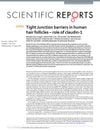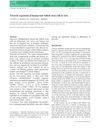TLDR Hair cells grown in a lab showed specific hair proteins.
The study conducted by Yukio Kitano and colleagues in 1992 focused on isolating human hair follicles from the scalp using dispase and collagenase treatment, followed by dispersion into a cell suspension with trypsin. These cells demonstrated good proliferation and could be subcultured 7 to 8 times. The culture medium used was MCDB 153 HAA, supplemented with amino acids, hydrocortisone, insulin, EGF, and bovine brain extract, with a Ca++ concentration of 0.1 mM. Immunohistochemical analysis confirmed that these cells expressed keratins specific to hair-forming cells.
248 citations
,
April 1988 in “Differentiation” Human and bovine hair follicles have distinct cytokeratins specific to hair-forming cells.
198 citations
,
October 1986 in “Differentiation” 81 citations
,
May 1986 in “Journal of Investigative Dermatology” 52 citations
,
February 1986 in “Journal of Histochemistry & Cytochemistry” Some hair proteins are specific to hair, while others are also found in skin cells.
88 citations
,
January 1981 in “British Journal of Dermatology” A new method helps grow human hair cells using a cow eye lens.
 39 citations
,
August 2018 in “Scientific reports”
39 citations
,
August 2018 in “Scientific reports” Claudin-1 is important for the barrier function and growth of hair.
 14 citations
,
April 2011 in “Cell Proliferation”
14 citations
,
April 2011 in “Cell Proliferation” Scientists can grow human hair follicle stem cells in a lab without changing their nature, which could help treat hair loss.
 May 2016 in “Research opinions in animal & veterinary sciences”
May 2016 in “Research opinions in animal & veterinary sciences” Maternal aspartame consumption during pregnancy leads to skin damage and higher apoptosis in newborn rat offspring.

Alopecia areata is an autoimmune disease affecting hair follicles and may harm heart health.
18 citations
,
February 2017 in “Molecular Medicine Reports” Activating Notch signaling can kill basal cell carcinoma cells.



